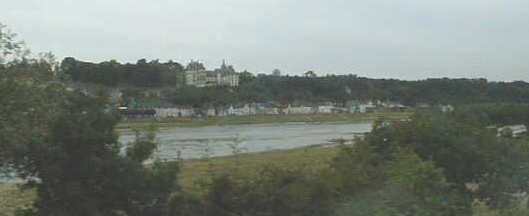
West Virginia University in Vendée, France

The drive along the Loire River from Tours to Chambord is one of the most beautiful and historically significant in Europe. Unfortunately, not all is well in this enchanted world. The preceeding busy weekend and the full day yesterday has not left all our WVU-Vendéens in the most refreshed of states. One of us, Betsy Goosman, has fallen ill and will return by train to Les Sables accompanied by Dr. V. Lastinger. In addition, today's skies are grey (an exception in this valley, they say), and several of us are quite tired from a variety exertions -- the greatest being the weekend excursion to Barcelona, Spain that involved 24 hours of train travel. By the time we're out of the hotel parking lot, therefore a number of us are catching up on some much needed sleep. The ride through the "Valley of the Kings" is therefore not fully appreciated by all. I myself am feeling the strain of our efforts and am sure the fatique is showing in some of these reports (though typos are among my trade marks!). But since the stories of these places are a part of their being, I will try to give some account of them here. Please forgive the verbosity, but I believe most of these words merit their place in these pages.

From the site of our hotel in Tours to the castle of Chambord the sites are many, and they, too, are monuments to a time that was both the best and the worst. The French Renaissance of the sixteenth century (1500's) began in a climate of interior peace. The long, great struggles with the English were largely over, and the new wars in far away Italy served largely as the proving grounds for ambitious young noblemen -- and as a source of artistic inspiration that would revolutionize every element of French expression. By mid-century, however, the new teachings of the Protestant Frenchman John Calvin had swayed the hearts of many. Soon the country was in the grips of violent civil wars between the new believers and those who would retain the dominance of French/Roman Catholicism. Above, we catch a glimpse of the Château de Chaumont. This is the place where the militant Catholic Catherine de Médicis tried to exile Diane de Poitiers upon the death of Henri II after his jousting accident in 1559. Henri's death would plunge France into the darkest years of the civil wars, and it would alos open up direct hostilities between Catherine and Henri's former mistress, the "forever beautiful" Diane de Poitiers. Catherine, now regent, hated Diane perhaps as much as the heretic Protestants. She would thus use her new authority to take over Diane's cherished Chenonceaux, whose beauty is truly the equal of Diane's and which we will visit this afternoon. The "consolation castle" of Chaumont is also a true thing of beauty, but for Diane it was only a reminder of Catherine's omnipotence. Diane would thus refuse to live here and would spend her last days retired from society.
Also on our route today is the magnificent castle of Amboise, most famous in history as a place where hundreds of Protestants were massacred in 1560. Meeting here on their way to nearby Blois to ask for a royal grant to freely practice their faith, the Protestants are accused of plotting against the royal family. Those captured are killed by a variety of means: some are hanged, some are decapitated, some are drawn and quartered (limbs tied to four horses and pulled to pieces), some are defenestrated (thrown from upper floor windows), some are put into sacks and thrown into the Loire to drown. The heads and bodies of the victims are hoisted on poles or hung over the walls of the castle for all to see. Legend has it that as the massacre continued, Catherine de Médicis, her son François II, and her daughter-in-law, the luckless Mary Stewart, would come and dine on the terrace of the castle among the stench of decomposing bodies. They are said to have feasted as they watched the agony of those slowly dying as the massacre dragged on around them... The famous Protestant soldier and writer, Agripa d'Aubigné passed through here as the bodies still rotted and wrote some of the most powerful pages of French poetry on this and other events of the Religious Wars, Les Tragiques. Soon, Agripa was to gather an army of Protestants that would head south into current Vendée and take by siege the prosperous Abbey of Maillezais (which we visited on June 18).
Our drive will also take us by the Château de Blois itself. This castle
is associated primarily with Louis XII (king from 1498 to 1515) and his wife Anne de
Bretagne. One of the earliest great Renaissance castles, Blois was inspired by the
art Louiz XII witnessed in Italy during his military campaigns there. His
successor, François I, would also fight in Italy, and the staircase he added to Blois is
a direct predecessor of the concepts around which he would build Chambord, in the
countryside not far away (pictured below).
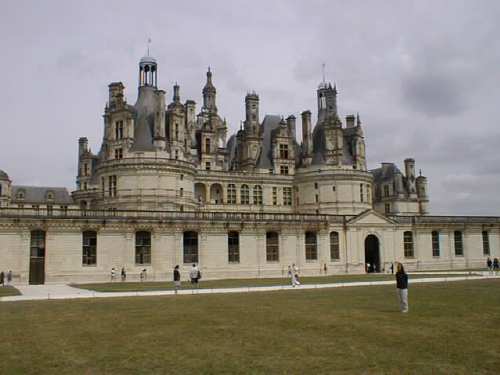
The wars in Italy pitted the French kings against their enemies in the
Germanies and in Spain in a fight for the wealthy cities of the great peninsula.
François I's greatest personal foe was Charles Quint who already ruled Germany, Holland,
and Spain. All he needed was Italy to complete the circle around France. As
François and Charles fought it out, Henry VIII laughed it up, and enjoyed greats feasts
from both as each courted his support against to other -- no wonder Henry VIII got so
fat!!! War was not the only thing on François's mind, however. On each of his
returns to France he brought back both the works and the artists themselves that most
impressed him in Italy. Most famous of these artists is one Leonardo de Vinci,
principal designer of Chambord. Below is the amazing double spiral staircase
that is the heart of this castle, which is according to some at once the last great Gothic
structure in France and the first "Gargantuan" monument of the
Renaissance. (I say "Gargantuan" because as Chambord was being built,
François Rabelais was writing the stories of the giant that would change the French
language much as the work of Shakespeare would revolutionize our English).
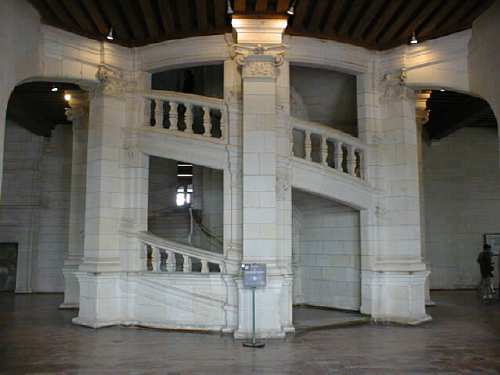
The Salamander, a magic creature that rises from the fire, is the embem of
François I. The "F" below is self-explanatory, but it's worth
noting that the animal seems to derive its attributes from the simple fact that
salamanders living in logs would crawl out when the logs were put on the fire, thus giving
the impression of a creature born of fire. You can perhaps make out the flames
flowing from the creature's mouth below.
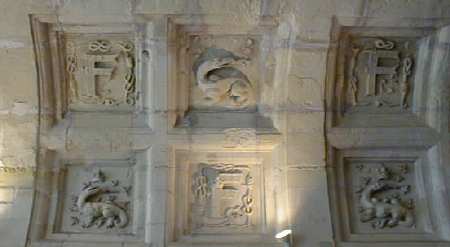
Below, a portrait of François I as young man in the years when he and Leonardo were beginning work on Chambord.
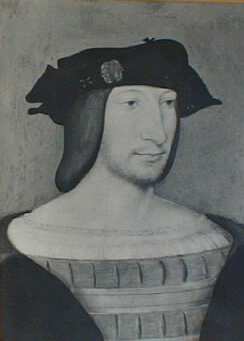
Below, Mona Iskander enjoys the view from one of the terraces of Chambord, and
one the staircases across the courtyard.
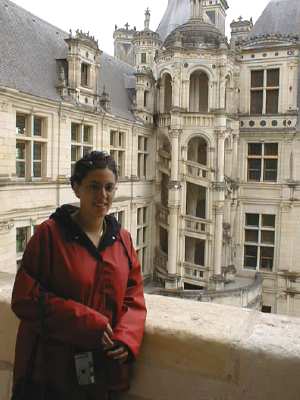
At midday, we pause for a very pleasant and refreshing luncheon near the site of our next visit. A stiff round of coffee for all, combined with the inspration provided by the magnificent Chambord, has us ready and willing for our nest visit.
Below is surely one of the most charming and beautiful buildings in all the world. Built on the Cher river, Chenonceau is known as the "Château des six femmes", the castle of the six ladies. The first lady, Catherine Briçonnet, was the wife of Thomas Bohier, the minister of finances under Charles VIII, Louis XII, and François I. The fortune he amassed in this position allowed him to finance the building of the castle, but his travels, often to Italy in company of the kings he served, led him to turn over management of the construction to his wife. The general charm of this incredible structure is thus due uniquely to Catherine Briçonnet.
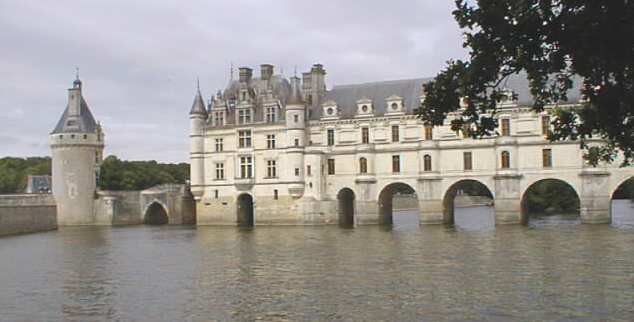
Upon Thomas Bohier's death in 1524, a review of the books reveals that the financier has been a bit liberal with his accounts. Unable to pay his father's debts, Bohier's son is forced to hand over the castle to the crown.
Upon François I's death in 1547, the castle falls to Henri II who arranges for
the residence of his mistress, the "always beautiful" Diane de Poitiers.
At the wedding party of his daughter to the king of Spain, Henri II celebrates with a
traditional display of prowess on the field. In a "freak" accident, Henri
breaks the lance of his opponent, friend, captain of the royal guard, Montgomery.
The broken lance then flies up and through the eye of the king. Henri was soon dead,
and Diane soon without her castle, having been forced to cede it to the powerful regent
Catherine de Médicis. During these years Chenonceau is the site of incredible
feasts and celebrations. The greatest nobles of the land come here to celebrate, and
the gardens, woods, and even the waters are decorated with "actors" from the
countryside around here who disguise themselves "half-naked" as nymphs,
sylphs, and sirens (mermaids).
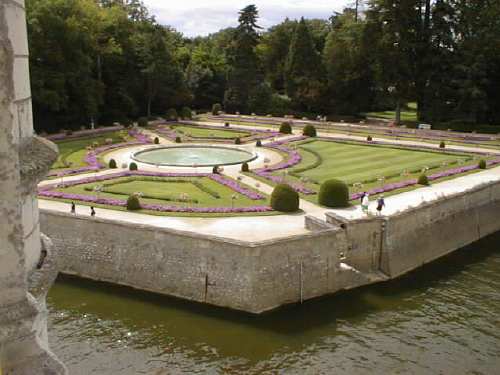
All this as the terrible Wars of Religion rolled through the land. Truly
the best and the worst of times. As Catherine de Médicis ruled here and throughout
France, as Diane de Poitiers languered in isolation, Henri II's and Catherine's sons
succeeded each other on the throne, each more ineffective than the other. François
II ruled less that a year, Charles IX was half crazy and ordered massacres of Protestants
forgetting the command in horror the next day. Catherine grows older and more bitter
with each passing year. Consoled only in her piety, her religious fanaticism grows
ever stronger. Finally the youngest of Catherine's and Henri's sons come to
rule. Although he shares the instabilities of his brothers, he seems at times to be
on track for a reasonable truce with the Protestants. Henri III (nor any of
his dead brothers), having no male heir also finds himself in the awkward position of
designating his legitimate successor. The most likely candidate, however -- a direct
descendent of Hugues Capet and the direct descendent of François I's sister the
marvellous and brillant Marguerite de Navarre -- is one of the detested
Protestants. Nevertheless, Henri recognizes the legitimacy of the claim of one Henri
de Navarre (who had had the foresight to wed Henri's equally deranged sister, Marguerite
de Valois -- see the recent movie Queen Margot.) The order seems to be headed
for the long awaited peace, until. . . Until, that is, the fanatic monk
Jacques Clément (compare John Wilkes Booth or Lee Harvey Oswald in American history),
surges forth from a friendly crowd and kills this king in the midst of his search for
peace. The year is 1589. Henri de Navarre will now have to fight for the
crown. Henri III's widow, Louis de Lorraine is devastated. It is now that she
who will occupy the charming castle of Chenonceau.
No longer will the lady of this castle occupy the vast and luxurious appartments of Catherine Briçonnet, Diane de Poitiers, or Catherine de Médicis. Louise de Lorraine moves up to one of the most isolated rooms of the castle. She decorates the chamber in black and white, the colors of mourning, also the only colors any cloth that will ever again drape her body. Below is the black and white chamber of Louise de Lorraine, widow of Henri III.
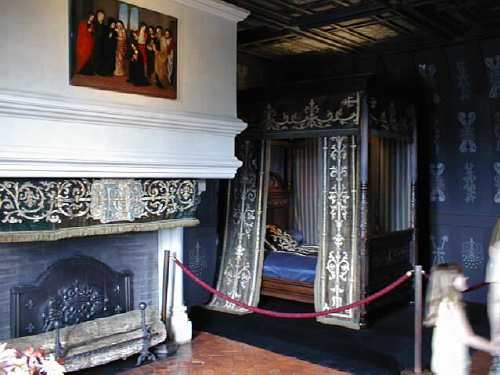
Below we see a detail of the walls of Louise de Lorraine's room. The cross on the left is on the motif of the "bones of death" and is surrounded by the shovels and picks of the grave digger. On the right are dark clouds and an "cornucopia", an endless flow of tears. . . This silent room speaks for itself.
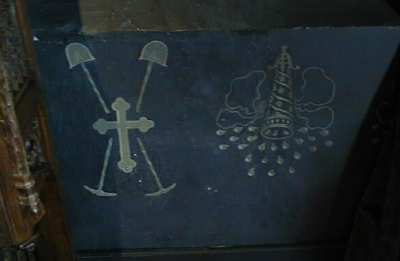
After Louise de Lorraine, the castle is somewhat abandonned until the 1700's when the fifth of the six ladies restores the life this place and brings the great minds of the world to enjoy its surroundings. Madame Dupin even hires Jean-Jacques Rousseau as governor for her son. In this role, Rousseau conceives and writes his Emile, ou l'éducation, a work that has directly or indirectly touched every child educated in the western world today. Thanks to Madame Dupin's generosity and openness of spirit, she was beloved by even the poorest inhabitants of the area. At the time of the Revolution, when many other castles in France were ravaged, Chenonceau survived in good state.
The last great lady of Chenonceau is Madame Pelouze, who worked through the later 1800's to restore and preserve Chenonceau to the ideal of Thomas Bohier and Catherine Briçonnet. A walk through that castle, across the river Cher, and through the woods leads to the tomb of Madame Pelouze, admired below by the lady Vendéennes, Megan Sadler and Mona Iskander.
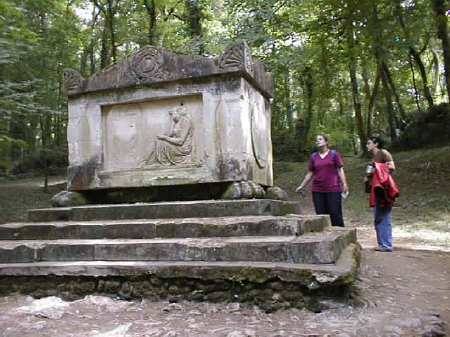
After the efforts of the last few days, the road from the Loire Valley back to the
coast of Vendée seems much longer than we had imagined. Approaching nearly 9:00 in
the evening, Dr. M. Lastinger (yours truly) consults with his inner self -- in the absence
of his colleague, Dr. Valerie, who returned yesterday with Betsy Goosman. His
solution to the problem is to offer a day off from class for any one who can spot
traditional Vendée windmill before our entry into Les Sables. As if by miracle, the
our driver has chosen a route the leads us over the Mont des Alouettes. Below,
Cristy Vogel and Amanda Walker are looking the wrong way -- the windmill is behind
them. Fear not, they and and a few other WVU-Vendéens will look around and see the
giants. Tomorrow (today as I write) is designated as an official day of
recovery. Class will resume on Thursday, and we will begin the final oral reports on
our final culture and communication projects. WVU-V 1998 is drawing toward its
end...

Stay tuned to WVU-V!
Go on to July 2, 1998.